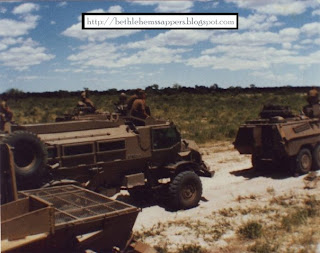The southern element of the FAPLA offensive was launched from the area of Cuito Cuanavale on 14 August 1987. The brigades involved here were 25 Brigade, already deployed east of the Cuito River at Tumpo, and 16, 21,47, 59, 66, 8, and 13 Brigades, which were deployed for this operation. Additional forces were held in reserve.

Intelligence having indicated that FAPLA had deployed a large number of armoured vehicles around Cuito Cuanavale, a team of South African officers was detached to UNITA to assist in the preparation of their anti-tank plan. UNTTA's detailed knowledge of the region facilitated a careful analysis of the likely approach routes and battlefield, and these were thoroughly prepared and mined. South Africa also agreed to provide air support if needed. In August, when the full scale of the FAPLA offensive had become clear, it was decided to also deploy South African artillery south of the Lomba River to support UNITA as needed. This deployment in support of UNITA was named "Operation Moduler".

FAPLA advanced with two brigades along each of two routes: 16 and 21 Brigades from Chambinga to the source of the Cunzumbia River, southward along its eastern bank to the confluence with Lomba River, and from there towards Mavinga; 47 and 59 Brigades from the area of the sources of the Hube, Vimpulu and Mianei Rivers to the source of the Cuzizi River, southward along its western bank to the Lomba, and from there towards Mavinga. Both forces moved very slowly through often thick bush, averaging 4 km daily and generally digging in for the night around 16h00.

One factor which slowed down their advance was uncertainty concerning the extent to which South Africa would support UNITA. FAPLA had already learned that South African mechanized forces move fast and strike hard, and that the SAAF's fighter-bombers are dangerous. The dangers of the sudden appearance of a mechanized force and of air attack, mandated relative concentration - both to deal with a mechanized attack and to stay within the umbrella of the accompanying air-defence systems, and the careful concealment of stationary forces. Neither requirement is conducive to fast movement in south-eastern Angola. The danger of ambush will have served to further slow the advance. Another factor was ongoing UNITA activity in the rear of the advancing forces and to the west of Cuito Cuanavale, hampering logistic support and the logistic movements of follow-on forces.

As more intelligence became available concerning the strength of the advancing FAPLA force, South Africa decided to deploy a mechanized force to block the advance of FAPLA's 47 Brigade at the Lomba River. This disrupted FAPLA's planned crossing of the Lomba, various FAPLA attempts to establish bridgeheads being defeated by UNITA forces supported by SA Army and SWA Territory Force elements. 47 Brigade suffered considerable losses in this fighting.

There was particularly heaving fighting on 13 and 14 September, when a FAPLA force crossed the Lomba and overran a UNITA position, killing some 40 UNITA men. FAPLA did not exploit, however, and this bridgehead was soon cleaned up. There were six engagements involving the South African force over these two days. Six South African soldiers were killed, two APCs were destroyed and two damaged in the fighting. The FAPLA force involved - an independent "tactical group" - suffered 382 men killed and lost six tanks and various other vehicles captured.
Angolan claims suggest that the SAAF had meanwhile set about isolating the battlefield. Specific claims include air strikes which disrupted FAPLA attempts to move up additional forces between 20 and 30 September. No further reinforcement was attempted by FAPLA thereafter.

There was a fierce clash on 3 October 1987, and this marked the turning point of the fighting. FAPLA's 47 Brigade was engaged and severely mauled, withdrawing without their main equipment in disorder during the night of 3/4 October to join up with 59 Brigade. Both brigades then withdrew to the area of their jumping-off point. 16 and 21 Brigades were also withdrawn. 47 Brigade lost 250 k
illed and a large amount of equipment destroyed or captured. Among the equipment losses were three SA-8 and two SA-9 launcher vehicles, eighteen tanks, three ICVs, sixteen APCs, five armoured cars, six 122 mm guns, the equipment of three light AAA batteries, and 120 logistic vehicles.
UNITA followed up the defeat of this FAPLA force, crossing the Lomba on 4 October and evicting FAPLA from their positions along the River.
FAPLA now adopted a defensive posture while it strove to move additional brigades into the area. 16 and 21 Brigades were deployed at the source of the Chambinga River, 59 Brigade and a "tactical group" between the Vimpulu and Mianei Rivers.
By mid-October the South African G-5s had advanced to within range of Cuito Cuanavale, quickly forcing the closure of the air base. They then turned to disrupting FAPLA use of the town and movement through it, and prevented the repair of the crucial.

bridge of the Cuito River. FAPLA forces east of the Cuito were hit by supply shortages as a result. Air support, already severely restricted by the presence of US supplied Stingers, was now further limited, the Angolan Air Force having been driven back to the air base at Menongue, 150 km west of Cuito Cuanavale - bringing longer reaction times and less time in the target area. The shelling also forced the withdrawal of the FAPLA headquarters to Nancova on the road to Menongue.
The major fighting involving the South African force was between 9 and 16 November, in the area of the source of the Chambinga and Hube Rivers. Sixteen South Africans died in this fighting. FAPLA losses to the combined South African/UNITA force were 525 killed and 33 tanks, three SA-13 launcher vehicles, fifteen APCs and 111 logistic vehicles captured or destroyed.
This fighting effectively ended Operation Moduler which wound up in mid-December.









0 comments:
Post a Comment